2006 LAND ROVER FRELANDER 2 warning light
[x] Cancel search: warning lightPage 2862 of 3229
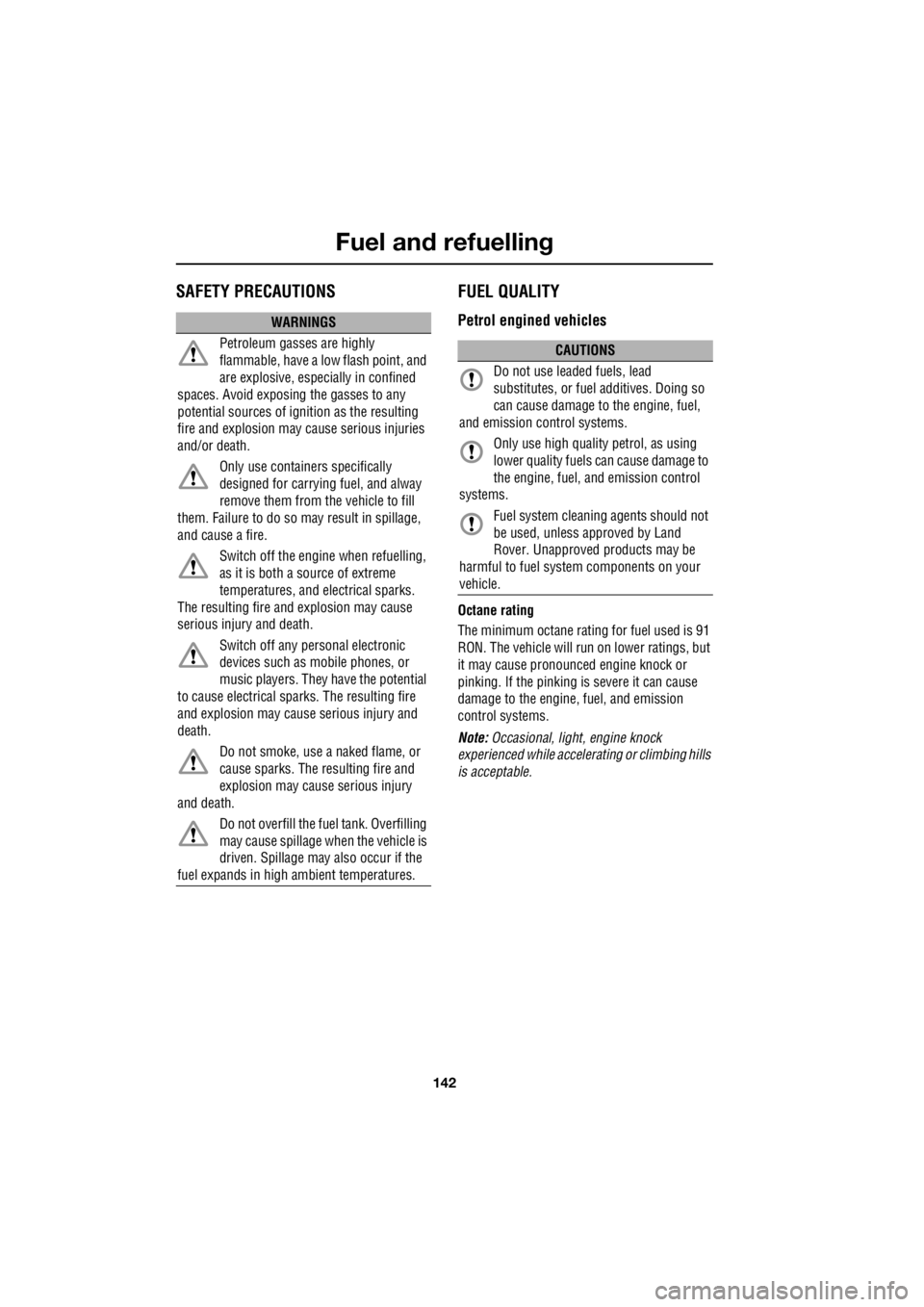
Fuel and refuelling
142
L
Fuel and refuellingSAFETY PRECAUTIONS FUEL QUALITY
Petrol engined vehicles
Octane rating
The minimum octane rating for fuel used is 91
RON. The vehicle will run on lower ratings, but
it may cause pronounced engine knock or
pinking. If the pinking is severe it can cause
damage to the engine, fuel, and emission
control systems.
Note: Occasional, light , engine knock
experienced while accelera ting or climbing hills
is acceptable.
WARNINGS
Petroleum gasses are highly
flammable, have a low flash point, and
are explosive, especially in confined
spaces. Avoid exposing the gasses to any
potential sources of ignition as the resulting
fire and explosion may cause serious injuries
and/or death.
Only use containe rs specifically
designed for carrying fuel, and alway
remove them from the vehicle to fill
them. Failure to do so may result in spillage,
and cause a fire.
Switch off the engine when refuelling,
as it is both a source of extreme
temperatures, and electrical sparks.
The resulting fire a nd explosion may cause
serious injury and death.
Switch off any personal electronic
devices such as mobile phones, or
music players. They have the potential
to cause electrical sparks. The resulting fire
and explosion may caus e serious injury and
death.
Do not smoke, use a naked flame, or
cause sparks. The resulting fire and
explosion may caus e serious injury
and death.
Do not overfill the fuel tank. Overfilling
may cause spillage when the vehicle is
driven. Spillage may also occur if the
fuel expands in high ambient temperatures.
CAUTIONS
Do not use leaded fuels, lead
substitutes, or fuel additives. Doing so
can cause damage to the engine, fuel,
and emission control systems.
Only use high quality petrol, as using
lower quality fuels ca n cause damage to
the engine, fuel, and emission control
systems.
Fuel system cleaning agents should not
be used, unless approved by Land
Rover. Unapproved products may be
harmful to fuel system components on your
vehicle.
Page 2865 of 3229
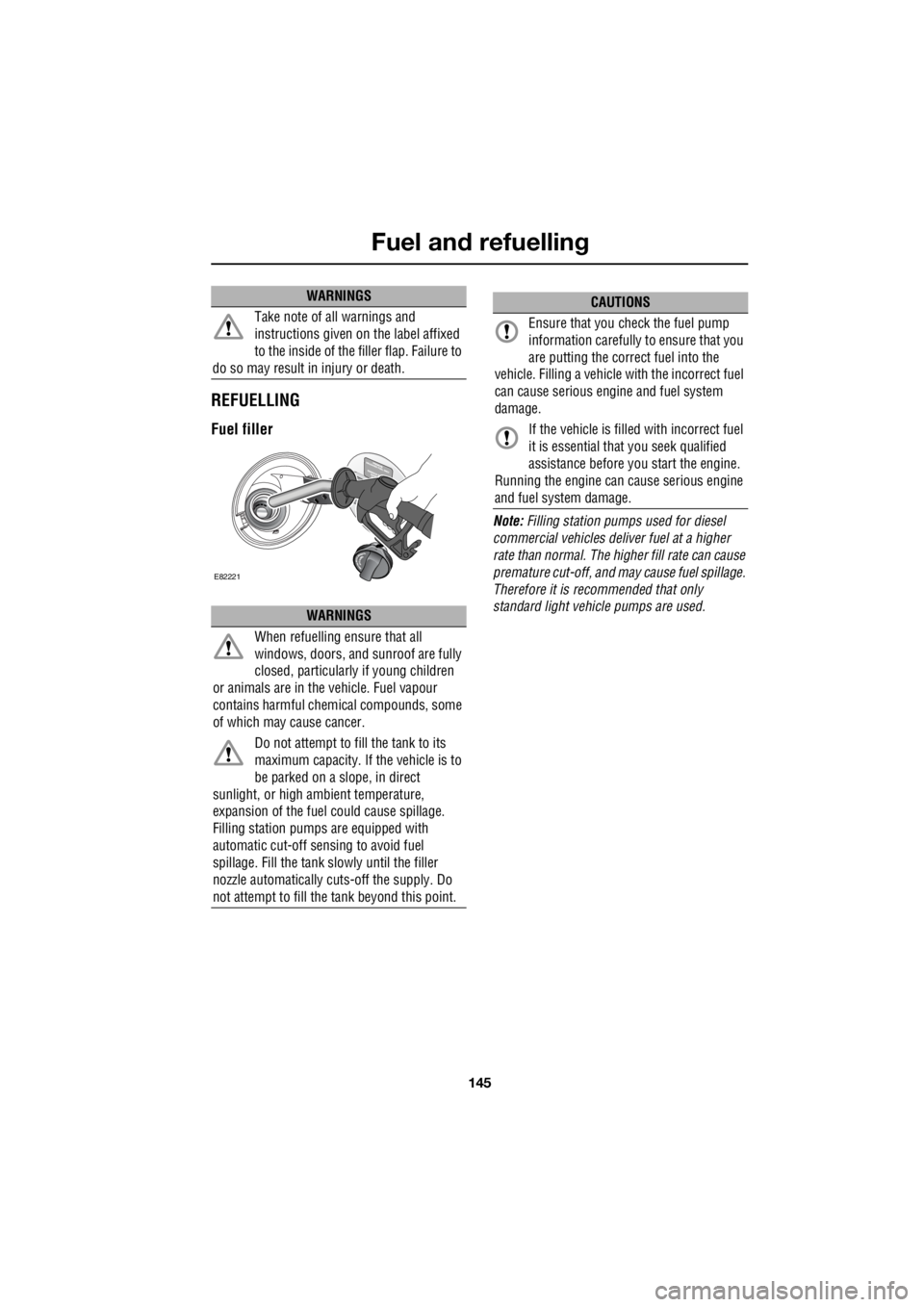
145
Fuel and refuelling
R
REFUELLING
Fuel filler
Note: Filling station pumps used for diesel
commercial vehicles deliver fuel at a higher
rate than normal. The hi gher fill rate can cause
premature cut-off, and may cause fuel spillage.
Therefore it is recommended that only
standard light vehicle pumps are used.
Take note of all warnings and
instructions given on the label affixed
to the inside of the filler flap. Failure to
do so may result in injury or death.
WARNINGS
When refuelling ensure that all
windows, doors, and sunroof are fully
closed, particularly if young children
or animals are in the vehicle. Fuel vapour
contains harmful chem ical compounds, some
of which may cause cancer.
Do not attempt to fill the tank to its
maximum capacity. If the vehicle is to
be parked on a slope, in direct
sunlight, or high ambient temperature,
expansion of the fuel could cause spillage.
Filling station pumps are equipped with
automatic cut-off sensing to avoid fuel
spillage. Fill the tank sl owly until the filler
nozzle automatically cuts -off the supply. Do
not attempt to fill the tank beyond this point.
WARNINGS
E82221
CAUTIONS
Ensure that you check the fuel pump
information carefully to ensure that you
are putting the correct fuel into the
vehicle. Filling a vehicle with the incorrect fuel
can cause serious engi ne and fuel system
damage.
If the vehicle is filled with incorrect fuel
it is essential that you seek qualified
assistance before you start the engine.
Running the engine can cause serious engine
and fuel system damage.
Page 2868 of 3229

Load carrying
148
L
LUGGAGE ANCHOR POINTS
1. Load securing rings.
• Four load securing rings are provided in
the rear luggage area to assist in safely
securing items carried.
2. Bag hooks.
• A bag hook is provided on each side of
the load area. These should be used to
secure relatively light items such as
shopping bags. Note:
A range of approved luggage retention
accessories are available from your Land Rover
Dealer/Authorised Repairer.
Reversible floor
The luggage compartment floor has been
designed with two load surfaces. A carpeted
side, which can be used in the normal way, and
a hard, wipe clean surface. The hard surface
can be used when transporting items which are
wet, dirty, or may damage the carpeted
surface.
To change between the two surfaces simply
remove the floor panel and reinstall it with the
required surface facing upwards.
WARNINGS
All items carried in the luggage area
should be properl y secured. Loose
items can cause serious injury or death
in the event of an accident or sudden
manoeuvre.
Do not use the bag hooks to secure
heavy items. Items which are not
properly secured can cause serious
injury or death during an accident or sudden
manoeuvre.
1
E83607
2
1
1
2
1
1
2
Page 2871 of 3229
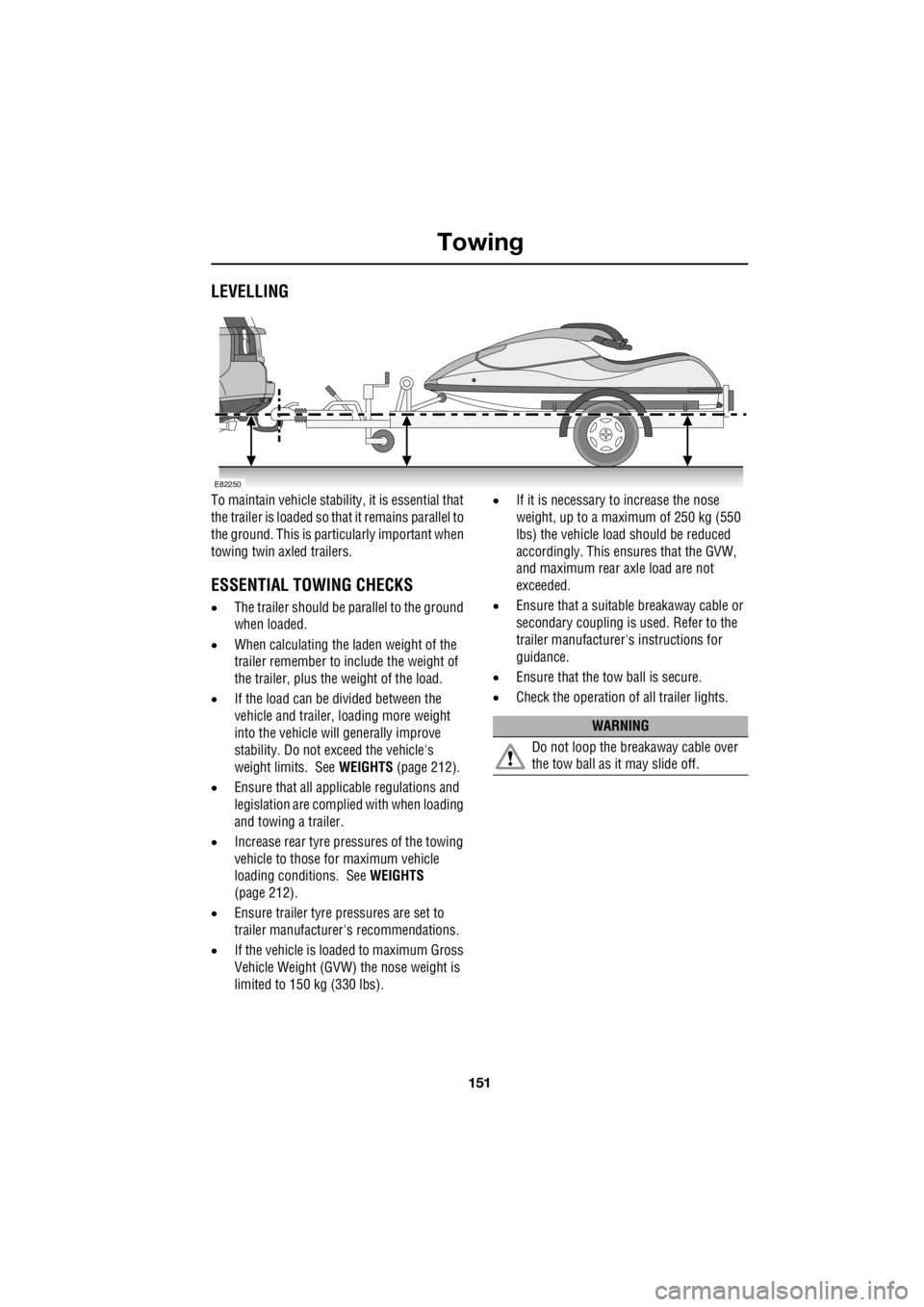
151
Towing
R
LEVELLING
To maintain vehicle stability, it is essential that
the trailer is loaded so that it remains parallel to
the ground. This is partic ularly important when
towing twin axled trailers.
ESSENTIAL TOWING CHECKS
• The trailer should be pa rallel to the ground
when loaded.
• When calculating the laden weight of the
trailer remember to include the weight of
the trailer, plus the weight of the load.
• If the load can be divided between the
vehicle and trailer, loading more weight
into the vehicle will generally improve
stability. Do not exceed the vehicle's
weight limits. See WEIGHTS (page 212).
• Ensure that all applic able regulations and
legislation are complied with when loading
and towing a trailer.
• Increase rear tyre pressures of the towing
vehicle to those for maximum vehicle
loading conditions. See WEIGHTS
(page 212).
• Ensure trailer tyre pressures are set to
trailer manufacture r's recommendations.
• If the vehicle is loaded to maximum Gross
Vehicle Weight (GVW) the nose weight is
limited to 150 kg (330 lbs). •
If it is necessary to increase the nose
weight, up to a maximum of 250 kg (550
lbs) the vehicle load should be reduced
accordingly. This ensures that the GVW,
and maximum rear axle load are not
exceeded.
• Ensure that a suitable breakaway cable or
secondary coupling is used. Refer to the
trailer manufacturer' s instructions for
guidance.
• Ensure that the tow ball is secure.
• Check the operation of all trailer lights.
E82250
WARNING
Do not loop the breakaway cable over
the tow ball as it may slide off.
Page 2874 of 3229
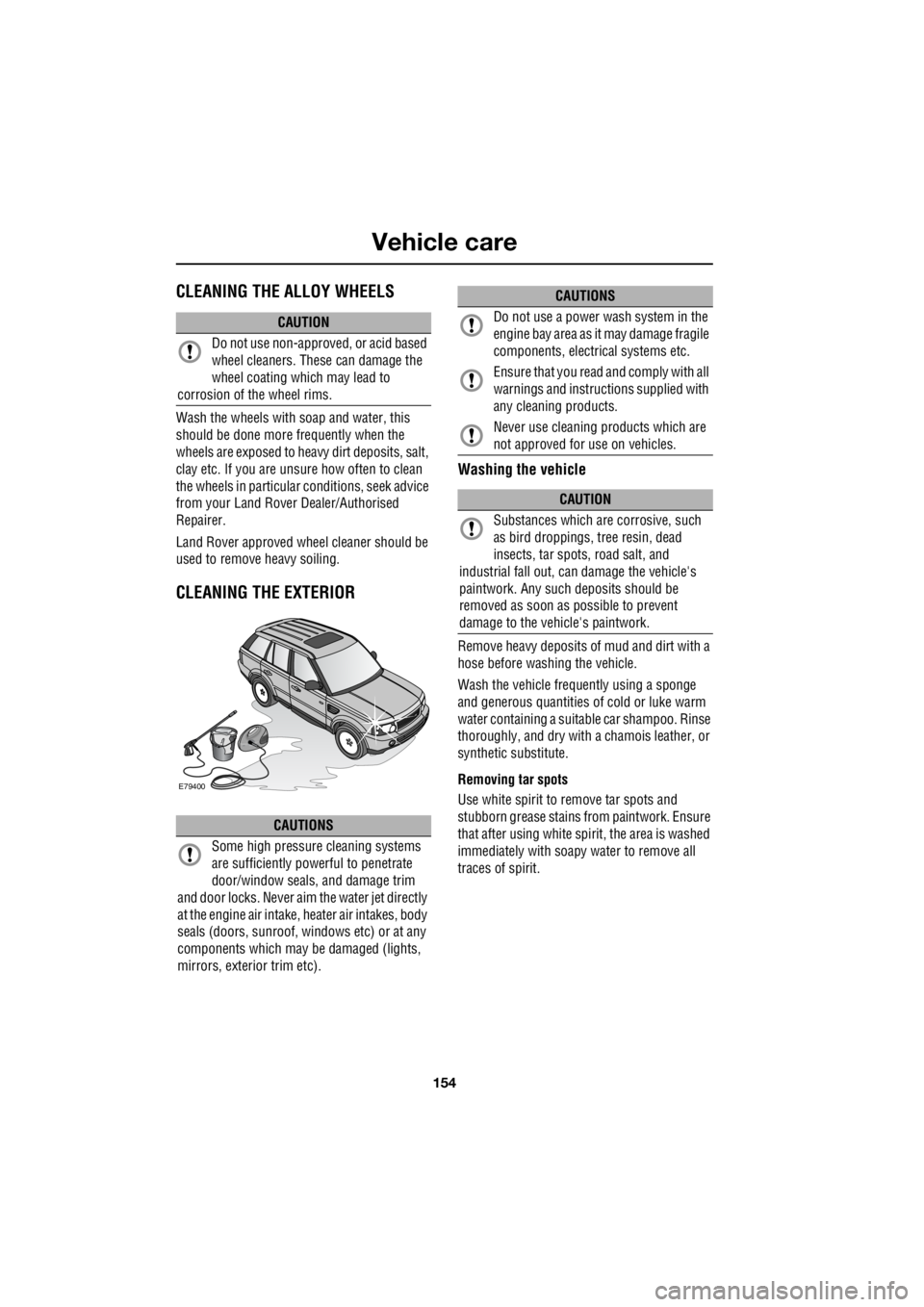
Vehicle care
154
L
Vehicle careCLEANING THE ALLOY WHEELS
Wash the wheels with soap and water, this
should be done more frequently when the
wheels are exposed to he avy dirt deposits, salt,
clay etc. If you are unsure how often to clean
the wheels in particular conditions, seek advice
from your Land Rover Dealer/Authorised
Repairer.
Land Rover approved wheel cleaner should be
used to remove heavy soiling.
CLEANING THE EXTERIOR
Washing the vehicle
Remove heavy deposits of mud and dirt with a
hose before washing the vehicle.
Wash the vehicle frequently using a sponge
and generous quantities of cold or luke warm
water containing a suit able car shampoo. Rinse
thoroughly, and dry with a chamois leather, or
synthetic substitute.
Removing tar spots
Use white spirit to remove tar spots and
stubborn grease stains from paintwork. Ensure
that after using white spirit, the area is washed
immediately with soapy water to remove all
traces of spirit.
CAUTION
Do not use non-approved, or acid based
wheel cleaners. These can damage the
wheel coating which may lead to
corrosion of the wheel rims.
CAUTIONS
Some high pressure cleaning systems
are sufficiently pow erful to penetrate
door/window seals, and damage trim
and door locks. Never aim the water jet directly
at the engine air intake, heater air intakes, body
seals (doors, sunroof, windows etc) or at any
components which may be damaged (lights,
mirrors, exterior trim etc).
E79400
Do not use a power wash system in the
engine bay area as it may damage fragile
components, electrical systems etc.
Ensure that you read and comply with all
warnings and instruct ions supplied with
any cleaning products.
Never use cleaning products which are
not approved for use on vehicles.
CAUTION
Substances which are corrosive, such
as bird droppings, tr ee resin, dead
insects, tar spots, road salt, and
industrial fall out, can damage the vehicle's
paintwork. Any such deposits should be
removed as soon as possible to prevent
damage to the vehicle's paintwork.
CAUTIONS
Page 2876 of 3229
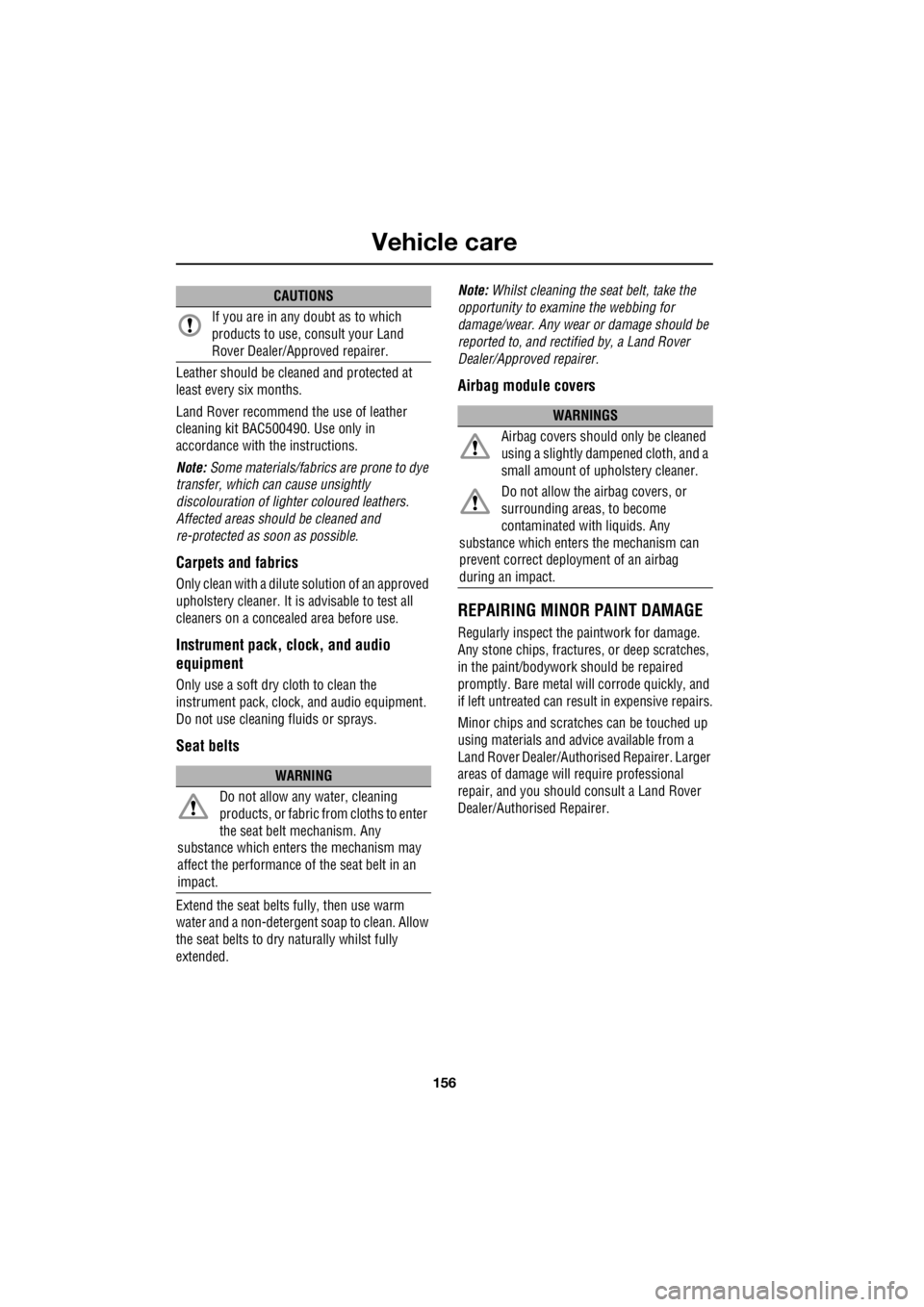
Vehicle care
156
L
Leather should be clea ned and protected at
least every six months.
Land Rover recommend the use of leather
cleaning kit BAC500490. Use only in
accordance with the instructions.
Note: Some materials/fabrics are prone to dye
transfer, which can cause unsightly
discolouration of lighter coloured leathers.
Affected areas should be cleaned and
re-protected as soon as possible.
Carpets and fabrics
Only clean with a dilute solution of an approved
upholstery cleaner. It is advisable to test all
cleaners on a concea led area before use.
Instrument pack, clock, and audio
equipment
Only use a soft dry cloth to clean the
instrument pack, clock, and audio equipment.
Do not use cleaning fluids or sprays.
Seat belts
Extend the seat belts fully, then use warm
water and a non-detergent soap to clean. Allow
the seat belts to dry naturally whilst fully
extended. Note:
Whilst cleaning the seat belt, take the
opportunity to examine the webbing for
damage/wear. Any wear or damage should be
reported to, and rectified by, a Land Rover
Dealer/Approved repairer.
Airbag module covers
REPAIRING MINOR PAINT DAMAGE
Regularly inspect the paintwork for damage.
Any stone chips, fractures, or deep scratches,
in the paint/bodywork should be repaired
promptly. Bare metal wi ll corrode quickly, and
if left untreated can resu lt in expensive repairs.
Minor chips and scratc hes can be touched up
using materials and advi ce available from a
Land Rover Dealer/Authoris ed Repairer. Larger
areas of damage will require professional
repair, and you should consult a Land Rover
Dealer/Authorised Repairer.
If you are in any doubt as to which
products to use, consult your Land
Rover Dealer/Approved repairer.
WARNING
Do not allow any water, cleaning
products, or fabric from cloths to enter
the seat belt mechanism. Any
substance which enters the mechanism may
affect the performance of the seat belt in an
impact.
CAUTIONS
WARNINGS
Airbag covers should only be cleaned
using a slightly dampened cloth, and a
small amount of upholstery cleaner.
Do not allow the airbag covers, or
surrounding areas, to become
contaminated with liquids. Any
substance which enters the mechanism can
prevent correct deployment of an airbag
during an impact.
Page 2879 of 3229
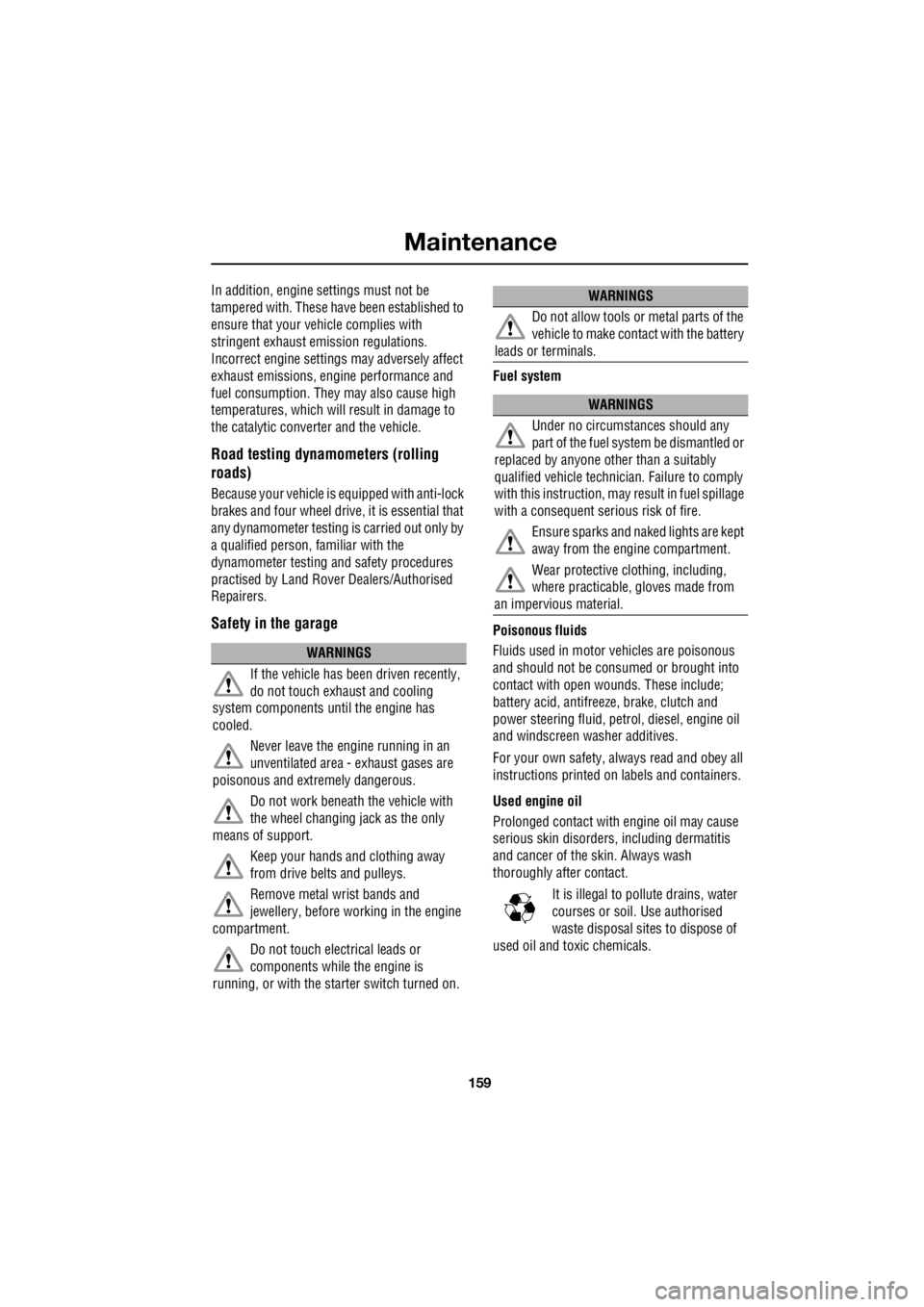
159
Maintenance
R
In addition, engine se ttings must not be
tampered with. These have been established to
ensure that your vehicle complies with
stringent exhaust em ission regulations.
Incorrect engine settings may adversely affect
exhaust emissions, engi ne performance and
fuel consumption. The y may also cause high
temperatures, which will result in damage to
the catalytic converter and the vehicle.
Road testing dynamometers (rolling
roads)
Because your vehicle is equipped with anti-lock
brakes and four wheel drive, it is essential that
any dynamometer testing is carried out only by
a qualified person, familiar with the
dynamometer testing an d safety procedures
practised by Land Rove r Dealers/Authorised
Repairers.
Safety in the garage
Fuel system
Poisonous fluids
Fluids used in motor vehicles are poisonous
and should not be consumed or brought into
contact with open wounds. These include;
battery acid, antifreeze, brake, clutch and
power steering fluid, petr ol, diesel, engine oil
and windscreen washer additives.
For your own safety, al ways read and obey all
instructions printed on labels and containers.
Used engine oil
Prolonged contact with engine oil may cause
serious skin disorders, including dermatitis
and cancer of the skin. Always wash
thoroughly after contact.
It is illegal to pollute drains, water
courses or soil. Use authorised
waste disposal sites to dispose of
used oil and toxic chemicals.
WARNINGS
If the vehicle has been driven recently,
do not touch exhaust and cooling
system components un til the engine has
cooled.
Never leave the engine running in an
unventilated area - exhaust gases are
poisonous and extremely dangerous.
Do not work beneath the vehicle with
the wheel changing jack as the only
means of support.
Keep your hands and clothing away
from drive belt s and pulleys.
Remove metal wr ist bands and
jewellery, before working in the engine
compartment.
Do not touch electrical leads or
components while the engine is
running, or with the starter switch turned on.
Do not allow tools or metal parts of the
vehicle to make contact with the battery
leads or terminals.
WARNINGS
Under no circumstances should any
part of the fuel system be dismantled or
replaced by anyone other than a suitably
qualified vehicle technician. Failure to comply
with this instruction, may result in fuel spillage
with a consequent serious risk of fire.
Ensure sparks and naked lights are kept
away from the engine compartment.
Wear protective cl othing, including,
where practicable, gloves made from
an impervious material.
WARNINGS
Page 2882 of 3229
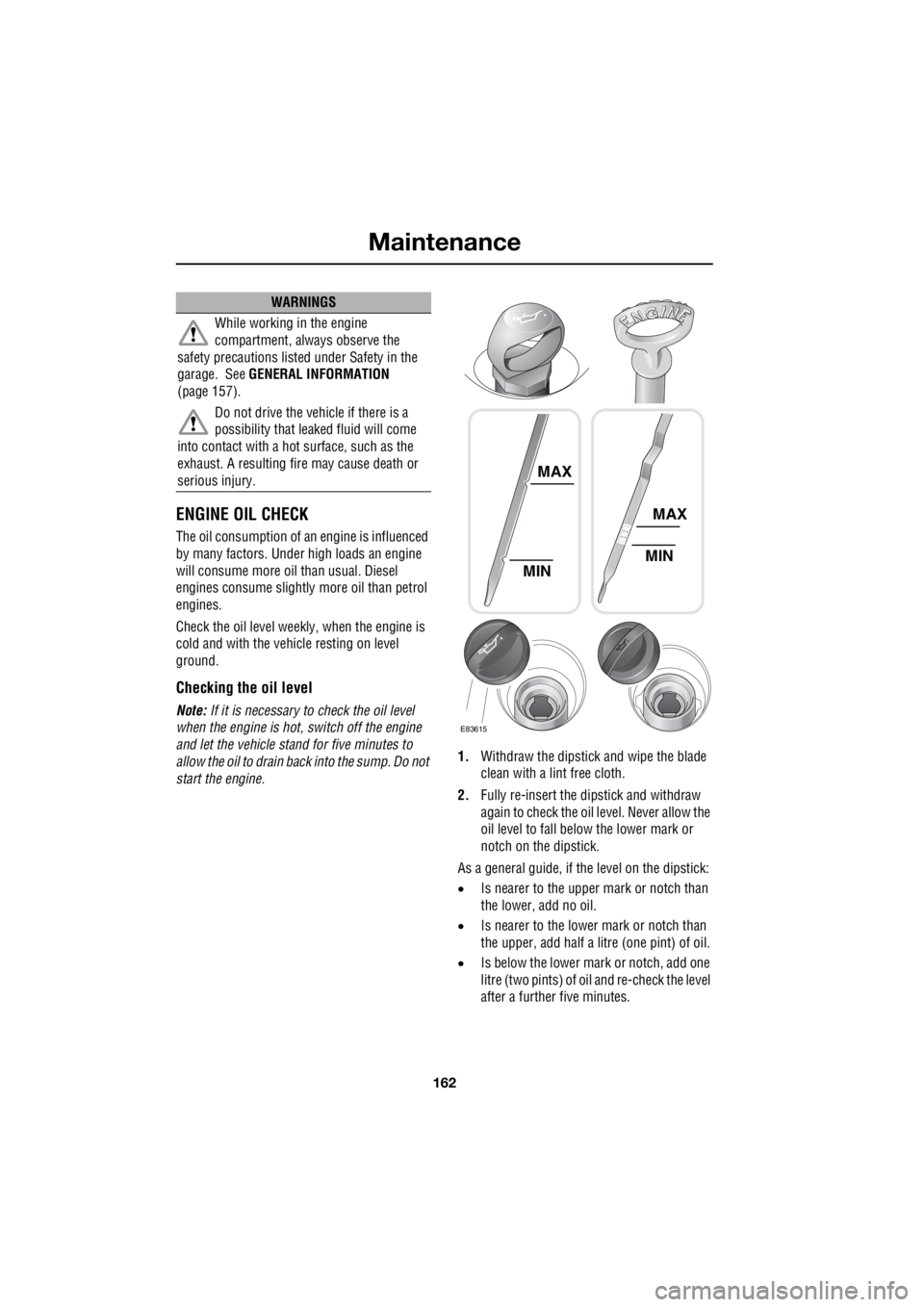
Maintenance
162
L
ENGINE OIL CHECK
The oil consumption of an engine is influenced
by many factors. Under high loads an engine
will consume more oil than usual. Diesel
engines consume slightly more oil than petrol
engines.
Check the oil level weekly, when the engine is
cold and with the vehicle resting on level
ground.
Checking the oil level
Note: If it is necessary to check the oil level
when the engine is hot, switch off the engine
and let the vehicle stand for five minutes to
allow the oil to drain back into the sump. Do not
start the engine. 1.
Withdraw the dipstick and wipe the blade
clean with a lint free cloth.
2. Fully re-insert the dipstick and withdraw
again to check the oil level. Never allow the
oil level to fall belo w the lower mark or
notch on the dipstick.
As a general guide, if th e level on the dipstick:
• Is nearer to the upper mark or notch than
the lower, add no oil.
• Is nearer to the lower mark or notch than
the upper, add half a li tre (one pint) of oil.
• Is below the lower mark or notch, add one
litre (two pints) of oil and re-check the level
after a further five minutes.
WARNINGS
While working in the engine
compartment, always observe the
safety precautions liste d under Safety in the
garage. See GENERAL INFORMATION
(page 157).
Do not drive the vehicle if there is a
possibility that leaked fluid will come
into contact with a hot surface, such as the
exhaust. A resulting fi re may cause death or
serious injury.
MAX
MIN
E83615
MAX
MIN